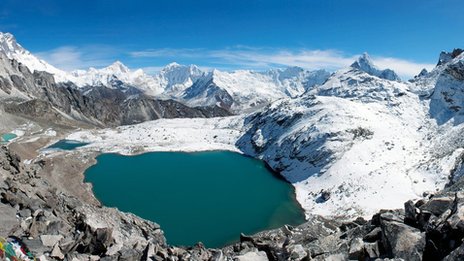INSUBCONTINENT EXCLUSIVE:
Image copyrightGetty ImagesClimate change poses a growing threat to the glaciers found in the Hindu Kush and Himalayan mountain ranges,
according to a new report
The study found that if CO2 emissions are not cut rapidly, two thirds of these giant ice fields could disappear
Even if the world limits the temperature rise to 1.5C this century, at least one third of the ice would go
The glaciers are a critical water source for 250 million people living across eight different countries
The towering peaks of K2 and Mount Everest are part of the frozen Hindu Kush and Himalayan ranges that contain more ice that anywhere else
on Earth, apart from the polar regions
But these ice fields could turn to bare rocks in less than a century because of rising temperatures, say scientists
Over the next few decades, the melting could accelerate thanks to warming and increased air pollution from a growing population
The air pollutants come from the Indo-Gangetic Plain, one of the world's most polluted regions
The dirty air makes the glacier situation worse by depositing black carbon and dust on the ice, hastening the thaw
Image copyrightGetty ImagesImage caption
Climbers near Mount Everest
If global temperatures rise by 2
degrees C, then half the glaciers would be gone by 2100
Even if the world takes dramatic action and limits warming to 1.5C by the end of the century, 36% of the glaciers will have
disappeared."This is the climate crisis you haven't heard of," said Philippus Wester of the International Centre for Integrated Mountain
Development (ICIMOD), who led the report
"Impacts on people in the region, already one of the world's most fragile and hazard-prone mountain regions, will range from worsened air
pollution to an increase in extreme weather events
But it's the projected reductions in pre-monsoon river flows and changes in the monsoon that will hit hardest, throwing urban water systems
and food and energy production off kilter." The area in question covers some 3,500km across Afghanistan, Bangladesh, Bhutan, China, India,
Myanmar, Nepal and Pakistan.The glaciers feed ten of the world's most important river systems, including the Ganges, Indus, Yellow, Mekong
and Irrawaddy, and directly or indirectly supply billions of people with food, energy, clean air and incomes
Image copyrightGetty ImagesImage caption
A glacier melting into a lake in the Himalayas
The impacts that
the scientists are worried about will hit not just those living in the mountains, but also the 1.65 billion people living in the river
valleys below - all are vulnerable to flooding and the destruction of crops
"Water is the theme that runs through many of the issues facing not just the mountain communities but the millions living downstream too
This report highlights how the retreat of snow and ice will change the way rivers behave, at first boosting their flow in spring and summer
over the coming years, but only until the ice has melted away," said Dr Hamish Pritchard from the British Antarctic Survey."For me, the
interesting question then is what happens in these major river basins in the years when the rains fail Without the ice reserve there in the
mountains to top the rivers up through the melt season, droughts will be harsher on those living downstream."This is a region where water is
a hot topic politically, economically and in day to day life, and harsher droughts could be a severe shock to an already fragile system
I read this report as a warning to prepare for these shocks."

